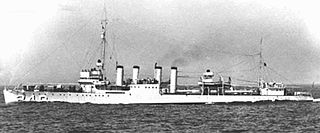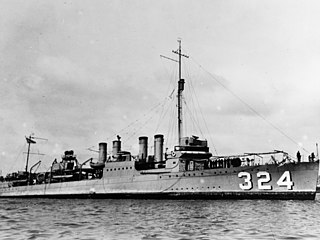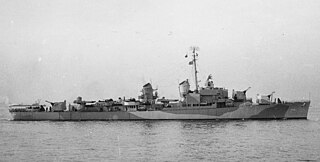
USS Jacob Jones (DD-130), named for Commodore Jacob Jones USN (1768–1850), was a Wickes-class destroyer. Jacob Jones was laid down by the New York Shipbuilding Corporation at Camden, New Jersey on 21 February 1918, launched on 20 November 1918 by Mrs. Cazenove Doughton, great-granddaughter of Commodore Jones and commissioned on 20 October 1919, Lieutenant Commander Paul H. Bastedo in command. She was sunk by a German submarine in 1942 during World War II.

The first USS Lansdale (DD-101) was a Wickes-class destroyer in the United States Navy during World War I and later designated, DM-6 in the years following. She was named in honor of Philip Van Horne Lansdale.

The first USS Radford (DD–120) was a Wickes-class destroyer in the United States Navy during World War I, later reclassified AG-22. She was named for William Radford.

USS Breese (DD-122) was a Wickes-class destroyer in the United States Navy during World War I, and later redesignated, DM-18 in World War II. She was the only ship named for Captain Kidder Breese.

USS Babbitt (DD–128) was a Wickes-class destroyer in the United States Navy during World War I and World War II, later classified as AG-102. She was named for Fitz Babbitt.

USS Terry (DD-25) was a modified Paulding-class destroyer in the United States Navy during World War I, and later in the United States Coast Guard, designated CG-19. She was the first ship named for Edward A. Terry, and the first ship commanded by future Fleet Admiral and Chief of Naval Operations Ernest J. King.

The first USS Mayrant (DD-31) was a modified Paulding-class destroyer in the United States Navy during World War I. She was named for Captain John Mayrant.

The second USS Trippe (DD-33) was a Paulding-class destroyer in the United States Navy during World War I and later in the United States Coast Guard, designated (CG-20). She was named for Lieutenant John Trippe.

USS Tracy (DD-214/DM-19) was a Clemson-class destroyer in the United States Navy during World War II. She was the only ship named for Secretary of the Navy Benjamin Franklin Tracy.

USS Truxtun (DD-229) was a Clemson-class destroyer in the United States Navy during World War II. She was the third ship named for Thomas Truxtun.

USS Sturtevant (DD-240) was a Clemson-class destroyer in the United States Navy during World War II. She was the first ship named for Albert D. Sturtevant.

USS Breck (DD-283) was a Clemson-class destroyer in the United States Navy following World War I. She was named for Joseph Berry Breck.

USS Isherwood (DD-284) was a Clemson-class destroyer in service with the United States Navy from 1919 to 1930. She was scrapped in 1931.

The fourth USS Preble (DD-345/DM-20/AG-99) was a Clemson-class destroyer in the United States Navy following World War I, and saw combat in World War II as a minelayer. She was named for Commodore Edward Preble.

The second USS Worden (DD-288) was a Clemson-class destroyer in the United States Navy following World War I. She was named for John Lorimer Worden.

USS William Jones (DD-308), a Clemson-class destroyer in the United States Navy, named for William Jones.

USS Robert Smith (DD-324) was a Clemson-class destroyer in service with the United States Navy from 1921 to 1930. She was scrapped in 1931.

USS Sicard (DD-346/DM-21/AG-100) was a Clemson-class destroyer in the United States Navy following World War I. She was named for Montgomery Sicard.
USS Bobolink (AM-20/AT-131/ATO-131) was a Lapwing-class minesweeper acquired by the United States Navy for the dangerous task of removing mines from minefields laid in the water to prevent ships from passing.

USS John R. Pierce (DD-753), an Allen M. Sumner-class destroyer, is the only ship of the United States Navy to be named for Lieutenant Commander John Reeves Pierce.




















